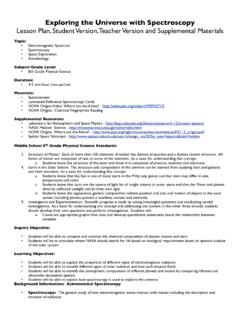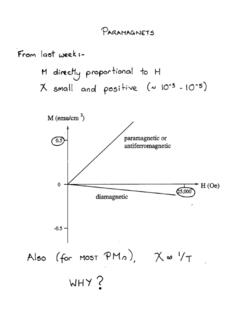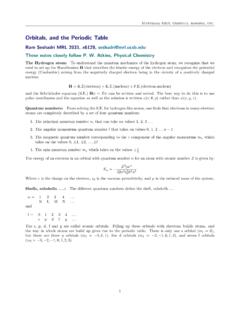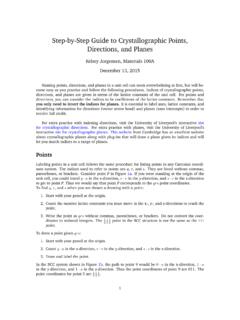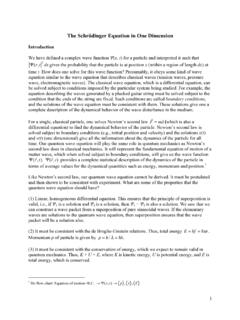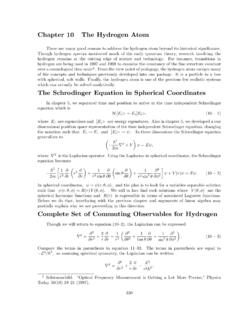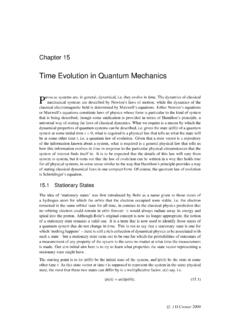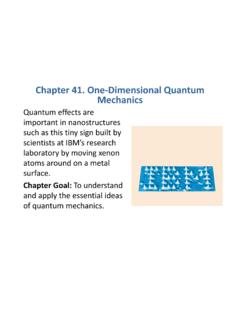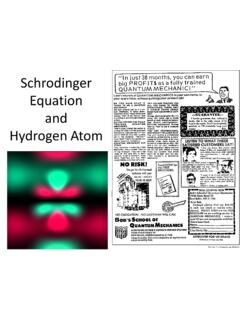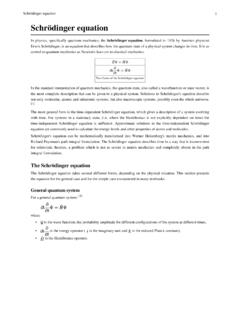Transcription of Band Structures and the Meaning of the Wave Vector k
1 band Structures and the Meaning of the Wave VectorkLeo K. Lamontagne1 IntroductionBand Structures are a representation of the allowed electronic energy levels of solid materials and are used tobetter inform their electrical properties. A band structure is a 2D representation of the energies of the crystalorbitals in a crystalline material. Sometimes referred to as spaghetti diagrams, a band structure plot canquickly reveal whether a material is metallic, semi-metallic, or insulating, and for those materials with bandgaps whether they are direct or indirect as well as the magnitude of the gap.
2 Additionally, the curvature ofthe bands can reflect the carrier mobility through those bands. A sample band structure for silicon is shownin Figure 1. As no bands cross from the valence band (bottom set of bands) to the conduction band (topset of bands), Si is a semiconductor with a band gap of about eV (based off of this calculation). Asthe conduction band minimum (orange dot) and the valence band maximum (blue dots) are not verticallyaligned, the band gap is one is able to quickly determine many materials properties by examining a band structure diagram,an intuitive understanding of how the band Structures arise and why they are presented in such ways requiresdeeper study.
3 The energies of the bands are calculated in k-space or sometimes called momentum space .This is an abstract space intimately related to real, or position space. As will be explained in this document,BANDSTRUCTURES ANDk-SPACEF igure 1: band structure of elemental Si (Fd3m) calculated using density functional theory (DFT). The blue circlesrepresent the valence band maximum and the orange circle is the conduction band minimum. The band gap of approxi-mately eV can be seen through the difference in energy (y-axis) at these two points.
4 As the valence band maximumand conduction band minimum are not vertically aligned, the band gap is thekwavevector is a convenient way to calculate and present the energies of the extended orbitalinteractions in begin, we first want to develop a relation between the energies of the wavefunction of a system withthe idea of a wavenumberk. We start by solving the Schr odinger equation for a free particle moving in 1dimension with no potential. ~22md2 (x)dx2=E (x)(1)Where~is the reduced Planck s constant,mis the particle mass, (x)is the particle wave function andEthe energy of the system.
5 We can guess a possible solution of (x) =Ceikx, whereCis a constant,iis 1andkwill be called the wavenumber. Thend (x)dx= ikCeikx(2)d2 (x)dx2=i2k2 Ceikx= k2 Ceikx(3)We can then multiply both the left and right sides of Equation 3 by ~22mto getL. K. LAMONTAGNE(2OF9)BANDSTRUCTURES ANDk-SPACE ~22md2 (x)dx2=~22mk2 Ceikx(4)And thus,E=~22mk2(5)We see for this solution that the energy of the system in which there is no potential on the particle hasa quadratic dependence on the wavenumberk. To get an intuitive sense of what this wavenumber is, wecan look at the de Broglie relation and see how the wavelength of a particle can be directly related to theenergy expression given in Equation 5.
6 The de Broglie relation elucidates the wave-like nature of matter andis given by =hmv=hp(6)Where is the wavelength of a particle,hthe Planck constant,mthe particle mass,vthe particle velocity,andpis the momentum of the particle. Instead of thinking of the wavelength of a particle, we can thinkin terms of its wavenumberk= 2 / which simply expresses the wave in terms of wavelengths per unitdistance, rather than the wavelength which is distance per period. Thenp=~k(7)Assuming the particle has no potential energy, only kinetic energy, thenE=12mv2=p22m(8)E=~22mk2(9)which is exactly the same as the energy of a free particle from Schrodinger s equation (Equation 5).
7 From these two results, we can begin to understand the relation of the momentum, wavenumber, andenergy of a system. Whilekhas units of 1/length, it is related to a real space wavelength and a momentumand can be used to calculate the energy of the system. In order to relate thiskto the calculation of bandstructures we must move from a single particle in 1 dimension to more complicated K. LAMONTAGNE(3OF9)BANDSTRUCTURES ANDk-SPACE2 band structure of a 1 Dimensional Chain of AtomsIn this section, we will see how periodic conditions on a crystal result in quantum states which can beexpressed conveniently in discrete wavenumbers which are related to the wavelengths of the crystal energies of the states characterized by these wavenumbers can be calculated and plotted giving rise toan orbital band , forming the basis for electronic Structures of more complicated crystals.
8 We assume a 1 dimensional chain ofNatoms separated by a lattice spacingaeach with just one valencesorbital. A periodic boundary condition is imposed so that theNthatom interacts with the 1statom of anadjacent chain. Thus, (x) = (x+Na)(10)Since the electron density must be unchanged with each lattice spacing as the chain is uniform, we have (x+a) = (x)and knowing (x) = (x) (x)which must be real, it must be that (x+a) = (x)where is a complex number such that = 1 Thus, (x+na) = n (x)(11)with N= 1to satisfy Equation 10, so =e2 ip/N=cos(2 p/N) +isin(2 p/N)(12)Herepis a quantum number that must span the integers from NtoN.
9 We can defineksuch thatk=2 now a quantum number with units of inverse length that is dependent on the number of atoms in thecrystal. For any reasonably largeN,kis functionally continuous. We can now write that (x+a) =e(ika) (x)(13)and see a solution to the wavefunction as (x) =eikx(14) The derivations here closely follow Chapter 4 of Cox s The Electronic structure and Chemistry of Solids Oxford UniversityPress (2005)L. K. LAMONTAGNE(4OF9)BANDSTRUCTURES ANDk-SPACEBy taking into Equation 13 we can further generalize the wave function assuming a periodic functionu(x) =u(x+a)as (x) =eikxu(x)(15)This is the familiar Bloch function.
10 Thus, we see that the wavefunction is a combination of the periodicpotentialu(x)on each atom with an exponential term that varies with the in the previous section,kis inversely related to a wavelength. Whereas before it was the wavelengthof a free particle, nowk= 2 / where is the crystal orbital wavelength. As shown in Figure 2, atk= 0the orbitals are all in phase with each other leading to no nodes between them and an infinite crystal orbitalwavelength. Askmoves from0, nodes are introduced into the chain when some orbitals switch phases untilk= /aat which every orbital is out of phase with its neighbors.
